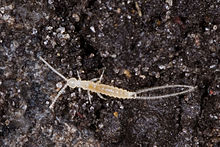Diplura
| Diplurans Temporal range: Late Carboniferous–Recent |
|
|---|---|
 |
|
| Campodea staphylinus, Belgium | |
| Scientific classification | |
| Kingdom: | Animalia |
| Phylum: | Arthropoda |
| Subphylum: | Hexapoda |
| Class: | Entognatha |
| Order: |
Diplura Börner, 1904 |
| Families | |
The order Diplura is one of the four groups of hexapods, alongside insects, springtails and Protura. They are sometimes called "two-pronged bristletails". Around 800 species have been described, of which around 70 occur in North America, 12 in Great Britain and two in Australia.
Diplurans are mostly 2–5 millimetres (0.08–0.20 in) long, although some species of Japyx may reach 50 mm (2.0 in). They have no eyes and, apart from the darkened cerci in some species, they are unpigmented. They have long antennae with 10 or more bead-like segments projecting forward from the head, and a pair of cerci projecting backwards from the last of the 11 abdominal somites. These cerci may be long and filamentous or short and pincer-like, leading to occasional confusion with earwigs. These cerci give the group its name, from the Greek diplo ("two") and uros ("tail"). Some diplurans have the ability to shed their cerci if necessary (autotomy); of all terrestrial arthropods, only diplurans have the ability to regenerate these lost appendages over a series of moults. Moulting occurs up to 30 times throughout the life of a dipluran, which is estimated to last up to one year. The abdomens of diplurans bear eversible vesicles, which seem to absorb moisture from the environment and help with the animal's water balance.
Diplurans are common in moist soil, leaf litter or humus, but are rarely seen because of their size and subterranean lifestyles. They have biting mouthparts and feed on a variety of live prey and dead organic matter. Members of the family Japygidae are mainly predatory and use their pincer-like cerci to capture prey, including springtails, isopods, small myriapods, insect larvae, and even other diplurans, while members of the family Campodeidae feed on soil fungi, mites, springtails, and other small soil invertebrates, as well as detritus. Those species with long cerci are herbivorous.
...
Wikipedia
